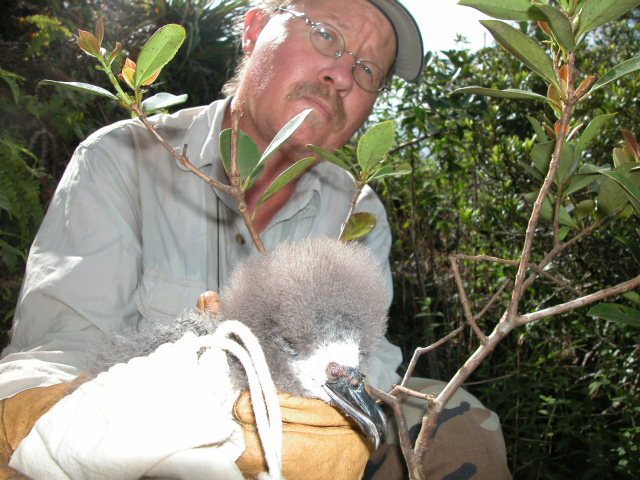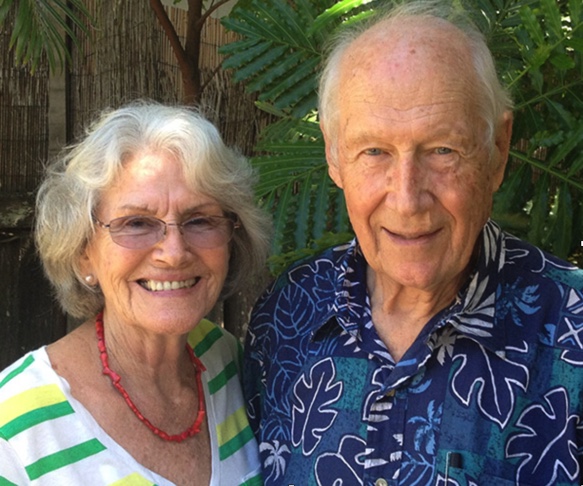(Contributed by Sheila Conant)

I met Fern not long after he took over the ʻalalā captive propagation project. He was working and living at Pōhakuloa. Marie Morin and I drove up to Pōhakuloa to meet the new aviculturist. Fern was working outside at a picnic table on which there was a microscope and a baby – his son, Kai – on a blanket. It’s an image I will never forget.
Fern was thrilled to take on the daunting task of bringing the ʻalalā back from the brink of extinction. The aviaries at Pohakuloa were small and primitive, and Fern had a modest budget. It was a war zone: helicopters flying a few hundred feet above, explosions nearly every day. The birds’ behavior clearly indicated they were severely stressed. It was through his determined efforts that Olinda Prison was renovated to provide the birds a new home. The rest is history, including our 35-year friendship, which is very dear to me. During his tenure as aviculturist, Fern got to know every bird by name and could recite its lineage and recount its behavior.
We did so many things together, most involving birds, but also trading orchids and water lilies, cheering one another through serious illnesses, exchanging views on dog training and cooking and enjoying birds, plants and invertebrates. He loved hearing the bullfrogs in the pond next to our home in Honolulu—they reminded him of his childhood home in Michigan. I’ve no idea how many times he was our house guest, nor I his, but I do remember it was always fun.
Fern was the best naturalist I have ever known. His depth of knowledge about birds, plants, invertebrates, ecosystems, and his devotion to conserving these priceless resources were incredible to me. Always confident of his convictions, Fern was never hesitant to speak his mind, whatever the views of his listeners. He was softspoken, but never backed down. Fern’s gentle nature, cheerful demeanor and his kindness were a joy to his friends and colleagues. He did scold me a few times because of something I did or thought (he was right to do so—usually), but it only deepened my respect and affection for him.
After some time, Fern handed over the ʻalalā project to others. He missed the birds very much, but he was joyous about all the new conservation and education projects he became involved in. He was dedicated, and always deeply thoughtful, in his management of Maui County Natural Area Reserves, a task he grew to love.
Fern was no stranger to personal tragedy, which he accepted with remarkable grace. His ability to accept disappointment, sadness and grief seemed boundless. His love of exploring native ecosystems, hiking, gardening, creating artwork must have been instrumental in helping maintain his calm demeanor in the face of loss and disappointment. There were also many joys in his life. When Fern told me about meeting Mary, who became his wife, his happiness was obvious. He grew happier with Mary than I thought possible, probably because she’s so good at laughing and smiling. My husband, David, performed their marriage at a wonderful celebration of their wedding with dozens of friends and relatives. I am so glad Fern and Mary were together when we lost Kai.
By the time Fern was ready to retire, he had grown optimistic about the future of conservation in Hawaiʻi because he had such faith in the younger folks. Many of those he helped with permits, access and information about their organisms (plants, snails, birds and other animals), have now stepped up to the challenges we face here in the extinction capital of the world. It was so good to see he felt he was leaving things in good hands when he retired at the end of last year. He died just two months later.
I will miss him more than I could ever say and will remember him whenever I see a lovely Hawaiian forest bird, a rare and beautiful Hawaiian plant or one of the spectacular orchids he gave me in full flower.
I recall Edna St. Vincent Millay’s words:
My candle burns at both ends;
It will not last the night;
But ah, my foes and oh, my friends—
It gives a lovely light.
Dieter Mueller-Dombois

On July 19, less than a week shy of his 97th birthday, Dieter Müller-Dombois died. He was a towering figure in Hawaiian conservation for six decades. As a professor at the University of Hawaiʻi, he left his stamp on hundreds of students and faculty.
A video tribute to Müller-Dombois, produced in 2012 by the state Department of Land and Natural Resources, notes his profound contributions “to our knowledge of botanical science, ecology, and conservation in Hawaiʻi and beyond.
Flint Hughes of the U.S. Forest Service, who has built on Müller-Dombois’s work on ʻohiʻa, said Müller-Dombois “was interested in everything. He wanted to understand everything.” Hughes cites him as a co-author on a recently published work describing how ʻohiʻa forests can quickly regrow in areas where they have been razed.
Sheila Conant, a colleague of Müller-Dombois at the University of Hawaiʻi, remembered him doing “some really wonderful work characterizing ecosystems in the Hawaiian islands, which are the epitome of examples of what sort of ecological and evolutionary processes take place on islands.”
“He was a good scientist but he was also a very kind person,” Conant said.
He is survived by his wife, Annette. The DLNR video is available at: https://www.youtube.com/watch?v=Vu0LC95xmh8
— Patricia Tummons

Leave a Reply